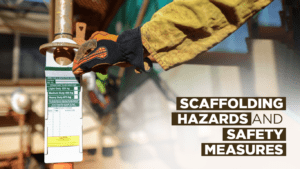
Scaffolding Hazards and Safety Measures
Every construction project needs scaffolding that can hold the weight of the workers and their tools. The scaffolding is used to aid the construction, maintenance, and repair of buildings, bridges, and other man-made structures. As these tasks involve accessing at heights and working on uneven ground, safety is the first concern during its construction.
Unsafe scaffolding has the potential that may result in serious injuries and in some cases can even be fatal. Hence proper fixing of scaffolding equipment and checking every scaffolding safety regulation is of utmost importance.
While we have elaborated on every aspect of scaffolding, this article specifically focuses on – Scaffolding Safety Control Measures – that will help eliminate any chance of casualties and injuries.
Importance Of Scaffolding Safety
Scaffolding safety is a set of rules and practices that make sure scaffoldings are used in the right way and safely. It’s a set of precautions that must be taken when building, inspecting, using, and tagging scaffolds. By following OSHA’s rules and requirements for working on scaffolding, workers can reduce or eliminate their risk of falling, getting electrocuted, or being hit by falling objects.
Scaffolding safety measures are important because they can help stop crises from happening again at work. With basic scaffolding requirements like better inspections, training, and controls to keep workers safe, frontline teams can make sure scaffolding is safe and build a safety culture from the ground up.
Types Of Scaffolding Hazards
1. Falls
Guardrail absence, faulty installation, and failure to deploy personal fall arrest systems cause falls. When working above 10 feet, OSHA requires fall protection. OSHA’s guidelines are the minimum; many general contractors need 100% fall protection at 6′ or higher when working on scaffolds. These contractors exceed OSHA regulations to improve safety.
2. Scaffold Collapse
Proper scaffolding prevents this hazard. Several considerations must be addressed before scaffolding. The scaffold must support the scaffold, materials, and personnel. Foundation stability, scaffold plank location, work surface distance, and tie-in regulations must all be considered before erecting a scaffold.
3. Falling Scaffolding Equipment
Scaffold dangers affect more than scaffold workers. Scaffold platform materials and tools have killed or harmed many people due to falling off of scaffolding equipment from heights. OSHA mandates two methods. To prevent tools from falling off work platforms, the installation of toe boards or netting is necessary. Barricades can prevent people from walking under work platforms and prevent hazards.
4. Electrocution
This is one of the most common scaffolding hazards that is caused by a lack of attention to OSHA guidelines. The scaffold must be 10′ from electrical risks. The electricity company must de-energize or insulate the hazard if this distance cannot be maintained. The power company and scaffolding company must work together to eliminate any risk of human danger.
Scaffolding Safety Control Measures
After acquiring knowledge on what are the most common hazards at construction sites, here are some tips to ensure that those hazards are mitigated.
1. Keep the workplace organized
Keep the work site clean and tidy to avoid slipping, tripping, and falling. When working on scaffolding, keeping tools in order can make it less likely that tools will fall off. It can also make it safer for workers to move around on the scaffolding.
2. Identify hazards
This should be done before work starts and as work is being done. Find possible scaffolding hazards and solutions before you start working. Having to work near power lines? Keep the scaffolding far enough away to stop the risk of getting electrocuted. During the project, will the scaffolding need to be moved? Before each erection, make a plan.
3. Proper training of scaffolders
As with every other part of a construction site, make sure your workers are trained and know what OSHA scaffolding safety regulations are. Training in how to set up and build scaffolding can make sure that overhead workers have a safe place to work and that the rig won’t fall down on its own.
4. Site reviewing
In addition to figuring out what the dangers are, you should keep looking at the construction site to find any new dangers that might come up. Keeping an eye out for things that could go wrong can help stop them from happening. As work goes on, people will feel more at ease at their jobs. This can make some people forget about safety, either by accident or on purpose.
Before starting work, make sure that a qualified professional has checked that the scaffolding or platforms are set up correctly and have all the necessary safety measures, such as the passive or collective railing systems that OSHA prefers to protect workers at heights.
5. Avoid overloading
It is very important to follow the manufacturer’s instructions about how much weight a scaffold can hold. If you put too much on a platform, it could break or tip over and knock a worker off.
6. Installing fall protection
This involves equipping the scaffold structure with guardrails, mid-rails, and top rails in suspended and supported scaffolds. Another point to note here is to provide scaffolders with personal fall arrest systems and PPE including hard hats, anti-slip boots, etc.
7. Careful dismantling
When a scaffold has been up for a long time, rust or wear and tear on its parts can make it harder to take down. But pulling or yanking on parts can be dangerous and cause a worker to lose their balance and fall.
When taking down any kind of scaffold, workers should take extra scaffolding safety measures and wear the right fall protection gear. Before moving on to the next level of a scaffold, each level should be completely taken apart.
8. Scaffolding tagging
Tags on scaffolds are used to keep your workers safe. It lets you know if a scaffold is safe to use or not. When tagging scaffolds, follow the steps below.
- A person who knows how to put up scaffolds and is qualified to do so must inspect and tag the scaffold.
- For tracking, each tag must have a clear, unique number that can be used to identify the scaffold.
- As required by law, all scaffolds must be inspected after they have been set up.
- All identification tags for scaffolds will be solid green, yellow, or red with black writing.
- Each tag’s front information is shown and filled out.
OSHA Compliance By AAIT
AAIT is a scaffolding equipment company in the USA that manufactures the finest quality equipment. Various types of scaffolding equipment that can be used in refineries, shipyards, construction companies, etc. are distributed by AAIT. Proper care and testing are done before the distribution of any component from the house of AAIT.
OSHA regulations with regard to each component’s build-up quality are taken care of. Besides this, in case of a defect, AAIT provides individualized customer care. This way, any concerns regarding the quality and quantity of scaffolding equipment are mitigated.












 Download
Download
Comments are closed